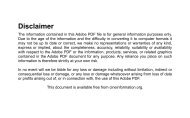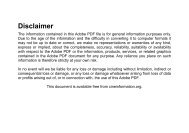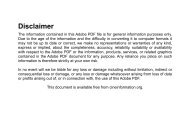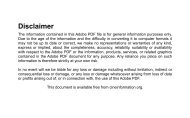Bell & Howell - Projector - Filmosound 641 - 642 ... - Cine Information
Bell & Howell - Projector - Filmosound 641 - 642 ... - Cine Information
Bell & Howell - Projector - Filmosound 641 - 642 ... - Cine Information
You also want an ePaper? Increase the reach of your titles
YUMPU automatically turns print PDFs into web optimized ePapers that Google loves.
50. TIMING BELT IDLER ADJUSTMENT<br />
Belt tension is not critical, although<br />
excessive tension will reduce belt life. Set<br />
the rewind belt idler so that the midpoint of<br />
the slack side of the belt can be pushed<br />
inward approximately i/8 inch by light<br />
pressure. Set the take-up belt idler so that<br />
the belt can be pushed down against the<br />
motor relay mounting bracket by light<br />
pressure.<br />
51. PROJECTOR SPEED CHECKS<br />
The speed of the projector is not<br />
adjustable. Therefore, speed checks are<br />
primarily for the purpose of determining<br />
that the equipment is operating properly<br />
and as a means of detecting excessive<br />
mechanism loads, damaged drive belt or<br />
similar conditions.<br />
A. Methods of Measurement<br />
Various devices and procedures can<br />
be used to check projector speed. The<br />
most common ones are as follows.<br />
(1) Photocell and Frequency Meter.<br />
Used to measure the number of<br />
interruptions of the projection<br />
beam per second, pulses per<br />
second are then converted to the<br />
projector speed. This method is<br />
quite practical if a quantity of<br />
equipment is handled.<br />
(2) "Strobotac" or similar strobe light.<br />
Usually synchronized with the<br />
interrupter shutter or shuttle.<br />
The shutter makes one revolution<br />
per frame. The shuttle makes<br />
one stroke per frame.<br />
(3) Tachometer (preferably having a<br />
speed range with a maximum<br />
speed of 150-200 RPM). Used to<br />
measure RPM of sprocket.<br />
(4) Timed Loop* Make a loop of<br />
exactly 120 frames. At sound<br />
speed the splice will pass the<br />
38<br />
aperture 12 times per minute +<br />
the permissible variation in speed<br />
and the timing error.<br />
B. Speeds at 240 Volts 50 CPS<br />
(1) Sound Speed<br />
Shutter - 1440 RPM + 2%<br />
Sprocket - 102.86 RPM + 5%<br />
(2) Silent Speed<br />
Shutter - 960 RPM + 5%<br />
Sprocket - 68.6 RPM + 5%<br />
52. LOOP RESTORER ADJUSTMENTS<br />
A. Test Film<br />
Since the film is transported by means<br />
of the sprocket holes and the shuttle and<br />
sprockets are synchronized by the gear<br />
train, there will always be the same<br />
number of frames in the lower loop, when<br />
the shuttle is at top of stroke position. The<br />
size of the loop, however, is dependent<br />
upon the actual length of the film in the<br />
loop. If the film is either stretched or<br />
shrunk, the size of the loop will change.<br />
This possible variation in the size of the<br />
loop, due to film condition must be recognized<br />
and allowance made for it in adjusting<br />
the loop restorer. Therefore, it is necessary<br />
to measure the stretch or shrinkage<br />
of the piece of film which is to be used in<br />
adjusting the loop restorer in order that<br />
the adjustment can be made with the<br />
highest possible degree of accuracy.<br />
Proceed as follows:<br />
(1) Count 40 frames of film and mark<br />
the first and last sprocket holes.<br />
(2) Place the trailing edge of the first<br />
sprocket hole at one end of a<br />
12 inch steel rule.<br />
(3) Smooth the film along the rule.<br />
Do not apply more than 2 to 3 oz.<br />
tension to the film as this might<br />
produce an erroneous measurement*<br />
(4) If there is zero shrinkage in the<br />
film, the trailing edge of the last








